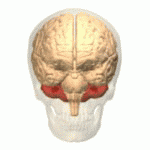Ataxic cerebral palsy
| Ataxic cerebral palsy | |
|---|---|
 |
|
| The cerebellum (shown in red) is the region of the brain affected by ataxic cerebral palsy | |
| Classification and external resources | |
| ICD-10 | G80.4 |
| ICD-9-CM | [1] |
Ataxic cerebral palsy is clinically observed in approximately 5-10% of all cases of cerebral palsy, making it the least frequent form of cerebral palsy diagnosed. Ataxic cerebral palsy is caused by damage to cerebellar structures, differentiating it from the other two forms of cerebral palsy, which are spastic cerebral palsy (damage to cortical motor areas and underlying white matter) and athetoid cerebral palsy (damage to basal ganglia).
Because of the damage to the cerebellum, which is essential for coordinating muscle movements and balance, patients with ataxic cerebral palsy experience problems in coordination, specifically in their arms, legs, and trunk. Ataxic cerebral palsy is known to decrease muscle tone.
The most common manifestation of ataxic cerebral palsy is intention (action) tremor, which is especially apparent when carrying out precise movements, such as tying shoe laces or writing with a pencil. This symptom gets progressively worse as the movement persists, causing the hand to shake. As the hand gets closer to accomplishing the intended task, the trembling intensifies which makes it even more difficult to complete.
Like all forms of CP, there is no "cure" for ataxic cerebral palsy. However, there are a number of diverse treatments which together have been used to limit the negative effects of the condition. Like all forms of CP it is most common for ataxic cerebral palsy to be congenital, resulting from errors in the development of the cerebellum and connexins during pregnancy. However it is also possible to be acquired via meningitis or even by head trauma, although the latter more often leads to one of the many forms of traumatic brain injury, which is categorically separate from cerebral palsy as a class.
Due to impaired balance, patients suffering from ataxic cerebral palsy often walk with their feet unusually far apart (a wide gait). In addition, the low muscle tone caused by ataxic cerebral palsy causes people suffering from the disease to appear very unsteady, as their body is constantly trying to counterbalance itself. Infants with the disease often take a significantly longer amount of time to be able to walk without support, and over 50% of all children with ataxic cerebral palsy experience some form of a learning disability or speech impediment.
...
Wikipedia
